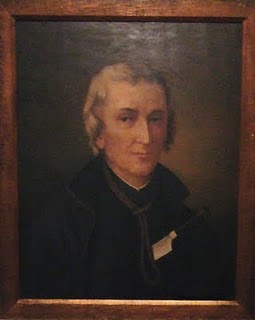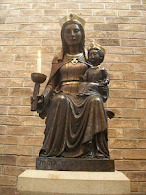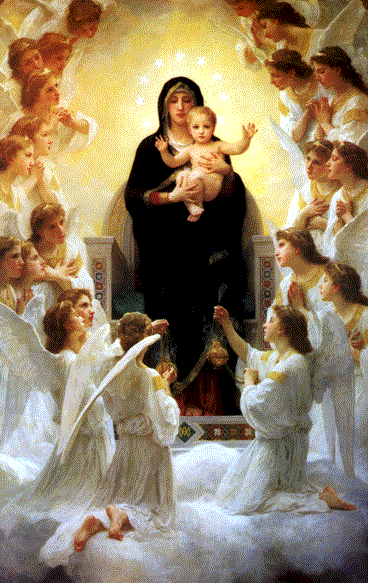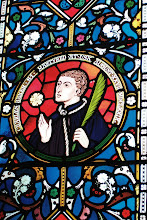The first thing I would like to do is say a very big THANK YOU to all of you lovely people who have left messages of support and prayers since I have been away. I am still with my family and will be until about the middle of May. Today, I have a touch of the sniffles so I thought it unwise to visit the sick in case I add to their problems. That brought me to my brother’s computer and the thought of (since I am in Canada) posting on Canadian Martyrs. As it turns out, the Canadian Martyrs, Jean de Brebeuf, Antoine Daniel, Gabriel Lalemant, Charles Garnier, and Noel Chabanel, like St David Lewis, were Jesuits and very brave and faithful men. Like all our Holy Martyrs, their stories are worth the telling. Here, briefly, is the story of one of those martyrs.

Saint Jean de Brébeuf (March 25, 1593 – March 16, 1649) was a Jesuit missionary, martyred in Canada on March 16, 1649. He was born in Normandy, France, studied at Caen and became a Jesuit in 1617. In 1623 he was ordained and in 1625 he sailed to Canada as a missionary, arriving on June 19, and lived with the Huron natives near Lake Huron, learning their customs and language, of which he became an expert (it is said that he wrote the first dictionary of the Huron language). Because of war between France and England, Fr Brébeuf returned to France but when the peace was signed, he returned to the Hurons in 1634, travelling 800 miles from Quebec via the Ottawa River. Fr Brébeuf told many of his experiences in Canada in the "Jesuit Relations", which are an invaluable source of early Canadian history. He was head of the Huron mission until 1638 when he relinquished the position to Fr Jérôme Lalemant. The Jesuits were frequently blamed for disasters like epidemics, battle defeats, and crop failures so his success as a missionary was very slow and it was only in 1637 that he made his first converts. However, by 1647 there were thousands of converted Huron.
The Iroquois , at war with the Huron, destroyed a large Huron village in 1648 and on March 16, 1649, 1,200 Iroquois captured the mission of St. Ignace and then a few hours later captured another Huron village where they seized Fr Brébeuf and his fellow Jesuit, Gabriel Lallemant, and brought them back to St. Ignace. There they were fastened to stakes and tortured to death by scalping, mock baptism with boiling water, fire, necklaces of red hot hatchets and mutilation. Fr Brébeuf made no outcry while being tortured and he astounded the Iroquois, who later cut out his heart and ate it in hopes of gaining his courage. The remains of fifty-five year old Fr Jean de Brébeuf were buried with Fr Lalemant's in one coffin, and today rest in the Church of St. Joseph at the reconstructed Jesuit mission of Sainte-Marie among the Hurons, near Midland, Ontario.
Jean de Brébeuf was said to have been massive in body, hugely strong, yet gentle in character. He was known as "The Apostle of the Hurons". The Natives called him "Echon", pronounced like "Ekon" – meaning "Healing Tree", because of how much he had helped the Hurons and of the medicines he brought them from Europe. Fr Jean de Brébeuf was canonized in 1930 with seven other missionaries, known as the Canadian Martyrs. His feast day in Canada is celebrated on September 26, while in the United States it is celebrated on October 19.

Saint Jean de Brébeuf (March 25, 1593 – March 16, 1649) was a Jesuit missionary, martyred in Canada on March 16, 1649. He was born in Normandy, France, studied at Caen and became a Jesuit in 1617. In 1623 he was ordained and in 1625 he sailed to Canada as a missionary, arriving on June 19, and lived with the Huron natives near Lake Huron, learning their customs and language, of which he became an expert (it is said that he wrote the first dictionary of the Huron language). Because of war between France and England, Fr Brébeuf returned to France but when the peace was signed, he returned to the Hurons in 1634, travelling 800 miles from Quebec via the Ottawa River. Fr Brébeuf told many of his experiences in Canada in the "Jesuit Relations", which are an invaluable source of early Canadian history. He was head of the Huron mission until 1638 when he relinquished the position to Fr Jérôme Lalemant. The Jesuits were frequently blamed for disasters like epidemics, battle defeats, and crop failures so his success as a missionary was very slow and it was only in 1637 that he made his first converts. However, by 1647 there were thousands of converted Huron.
The Iroquois , at war with the Huron, destroyed a large Huron village in 1648 and on March 16, 1649, 1,200 Iroquois captured the mission of St. Ignace and then a few hours later captured another Huron village where they seized Fr Brébeuf and his fellow Jesuit, Gabriel Lallemant, and brought them back to St. Ignace. There they were fastened to stakes and tortured to death by scalping, mock baptism with boiling water, fire, necklaces of red hot hatchets and mutilation. Fr Brébeuf made no outcry while being tortured and he astounded the Iroquois, who later cut out his heart and ate it in hopes of gaining his courage. The remains of fifty-five year old Fr Jean de Brébeuf were buried with Fr Lalemant's in one coffin, and today rest in the Church of St. Joseph at the reconstructed Jesuit mission of Sainte-Marie among the Hurons, near Midland, Ontario.
Jean de Brébeuf was said to have been massive in body, hugely strong, yet gentle in character. He was known as "The Apostle of the Hurons". The Natives called him "Echon", pronounced like "Ekon" – meaning "Healing Tree", because of how much he had helped the Hurons and of the medicines he brought them from Europe. Fr Jean de Brébeuf was canonized in 1930 with seven other missionaries, known as the Canadian Martyrs. His feast day in Canada is celebrated on September 26, while in the United States it is celebrated on October 19.








.JPG)

.JPG)






What part of Canada are you in? I'm in southern B.C. and my sister is in Calgary. I'll continue to pray for your family.
ReplyDeleteHello Shirley
ReplyDeleteThank you very much for your kindness. I appreciate your prayers, your support and your kind comments. I think I am quite a distance from where you and your sister are. I am on the other side of Canada, on the east coast. At least we are on the same continent now!!! I am actually in Newfoundland. It is gorgeous here and I think it is beautiful over your way also. Thanks for looking in and for your continued prayers. God bless you, Shirley.
I didn't realise you were so far away! Hope all is going well x
ReplyDeleteHello Mother of this lot
ReplyDeleteYes, I am a bit of a distance from Wales at present. Things aren't great here but God is good and everything will be O K. Thank you for looking in and please keep us in your prayers. God bless you and your lot!
Nice to see you Blogging again.
ReplyDeletePraying for you and your family.
Being in Canada, you are missing out on all the fun of the General Election over here. It's on TV all the time and repeated over and again. Even the news and weather are a repeat right now.
God bless you always.
Hello Victor
ReplyDeleteThanks for being so loyal. I am not back in Wales yet but I just wanted to keep in touch so decided to try and do an occasiional post when time permits. Please keep us in your prayers. Thanks and God bless you.
It's good to see you here! I've been praying for you and your family and will continue to do so.
ReplyDeleteGood morning Sister
ReplyDeleteThank you for your kindness. I am praying for you and yours too. God bless you all.
i enjoyed reading about Jean de Brebeuf. He seems to have written some Carols. Do you kn ow where I might find them I am Tom Clarke Flat 14, 42 Great Pulteney Street, bath ba2 4dr somerset.
ReplyDeleteengland.
Hello Anonymous
ReplyDeleteThank you for visiting and for your kind comment. I know Jean De Brebeuf wrote at least one Christmas Carol, "The Huron Carol". I don't know if he wrote any others. I know that there are lots of versions of "The Huron Carol" available on YouTube. As a matter of fact, since it is Advent and Christmas is approaching, I will post a YouTube version just for you. I hope you will look in again. God bless you.